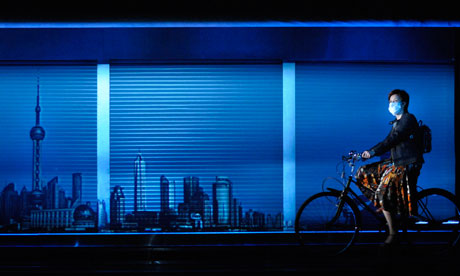
Over his 30-year career as a director and playwright, Robert Lepage has repeatedly come up with clever ways to change how we see theatre. Now he's come up with an idea that could very well change the way we read it.
Instead of publishing the script of his recent play, The Blue Dragon, Lepage's theatre company Ex Machina decided to take an entirely different route, commissioning Quebec City-based artist Fred Jourdain to transform it into a graphic novel.
Now published in English by Toronto's House of Anansi Press, Jourdain's gorgeous mise en images of the play, which appeared in Britain at the Barbican earlier this year, includes every word of dialogue spread over 176 pages of comic-book panels and cinema-inspired paintings.
The Blue Dragon, which Lepage co-wrote with longtime collaborator Marie Michaud, tells the story of a love triangle between Pierre Lamontagne, an expat art dealer in Shanghai; his ex-lover Claire Forêt, who has come to China from Canada to adopt a baby; and a young Chinese artist named Xiao Ling.
The Shanghai setting only partially seen (and heard) through the stage design is fully fleshed out in the book, while the characters retain a strong resemblance to the actors who played them in the original production. (The comic-book version of Lepage, as Lamontagne, looks pretty much exactly like him, if a little more stubbly.)
While I'm usually content to pick up a play's text when I can't see a production on stage, reading plays for pleasure can be a frustratingly incomplete experience. Plays aren't, after all, written to be read. (Closet dramas excluded, of course.) Particularly when it comes to practitioners of visually oriented theatre such as Lepage, words only capture a sliver of the work's appeal. I remember studying the script of one of Lepage's plays and thinking: "What's the big deal with this guy?" The Blue Dragon graphic novel goes much further in capturing what is so special about Lepage's work.
From Annie to Spider-Man: Turn Off the Dark, theatre hasn't been shy about stealing from comics culture; I wonder why the reverse hasn't been true? Sure, there are plenty of Shakespeare comic-book adaptations – such as the Manga Shakespeare series – but I can only think of a few fringe comic books based on contemporary plays. Many of us would enjoy reading a Complicite or Punchdrunk comic book, and I suspect War Horse could be turned into an excellent graphic novel.
More traditional, text-centred work might benefit from this treatment, too. Imagine reading one of Harold Pinter's plays and being able to see what's going on during those enigmatic pauses – at least according to one cartoonist's interpretation.
Brad Fraser, a fan of comic books, tells me he's at work on a graphic-novel adaptation of Snake in Fridge, his play which premiered at the Royal Exchange in Manchester in 2000. Will more playwrights follow suit?

